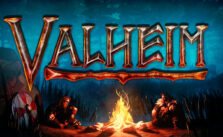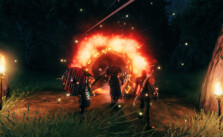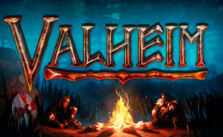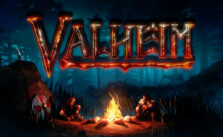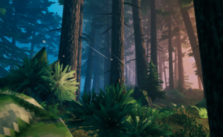Valheim: Beginner’s Guide to Game Mechanics

Basic Mechanics
There are many mechanics you’ll be grappling with for your entire stay in Valheim.
Stamina
The most important stat to manage carefully, stamina determines a lot of things and generally doesn’t recover too quickly, so wasting it is a big deal when you’re in combat or about to be. Take great care in ensuring you don’t get caught out with zero stamina by a pack of enemies.
Stamina is needed for: Running, Jumping, Swimming, Blocking, Attacking, Drawing and Holding an arrow, rolling, keeping a harpooned enemy tethered, and so on. Basically, everything that isn’t walking or standing still. Swimming without stamina will cause you to take damage and can kill you.
Health
You start out with a measly 25 HP, and this minimum will never increase. Health, without modifiers, will not recover much if at all. Food will increase this notably, and add to your regeneration significantly as well.
Food
Unlike many other survival games, food is not an absolute necessity to remain alive. It is, however, extremely important.
You can eat up to three different foods at a time, all with their own stat changes and durations associated. These are easily visible via the food item’s tooltip. Ration your better foods and keep a good supply on you when you go out.
Combat
Combat is relatively simple in concept. There is attacks (LMB), alternate attacks (MMB), blocking (RMB), dodging (RMB + Space), and parrying (Timed Block).
Parrying is a powerful move, but can be difficult on an enemy you’re still learning the moveset of. To do this, wait until the enemy has begun their attack swing (or similar) and block before it connects. When it does, if you timed it properly, you will be able to block more damage than you normally could, and the enemy will be staggered, open to critical hits. Parrying cannot be performed with a tower shield or similarly large shield without a parry modifier.
As of writing this, ranged attacks such as arrows or rocks can be parried, but this is assumed to be a bug of some nature. Purely elemental attacks or elemental effects cannot be blocked, but if it comes along with an initial hit of physical damage too, that can be blocked.
Using a bow is pretty straightforward, get the bow out, have arrows, draw until the circle is smallest, and shoot towards the enemy. Most of the time you will need to compensate by aiming over the enemy, but it gets a bit weird when you aim straight up/down, so be sure to practice with the bow before trying to fight anything dangerous with it. You can move and jump while drawing/losing arrows, but if you run out of stamina, you’ll simply put the arrow away. You can cancel drawing/holding with the block key to avoid wasting an arrow.
Cooking
Related directly to food, early game cooking is simple. You set up a campfire, place a cooking station over it, and cook meats on it. Once they sizzle the first time, they are done cooking and should be taken off. If you forget it over the fire, it will burn.
Skill Levels
As you perform actions, such as running, jumping, swimming, woodcutting, and so on, you will gain skill experience in the related skill. Early on this moves reasonably quickly, but tapers off as your levels increase. Mousing over each skill in the tab menu will tell you what it does. The increases are not massive, and levels are less important than your gear, but they definitely do have a notable impact overall.
Death
You will certainly die, and the first time will probably be to a tree falling on your head. Upon death, a grave will be created that holds all of the items you had when you died. You will also lose a bit of skill experience, but so long as you don’t make a consistent habit of getting killed, it should have a relatively negligible impact on your skill growth overall.
To regain your items early on, just run over to your grave and interact with them. You will receive all your items so long as they would not encumber you. You will then receive the Corpse Run status which significantly reduces stamina consumption and damage received for one minute.
Building
Building in and of itself is pretty straightforward. Place structures, enclose them, make sure it has a door so you can get in and out but the mean monsters can’t. There is a stability system, which is easy to use in basic terms. With the hammer out, preferably on the repair option so nothing obscures your vision, look at a piece of a structure. Going from Green to Red, green being very stable, and red being barely stable enough, the stability can be determined. Blue is special and means it is perfectly stable, meaning it is attached to the ground or similar.
Wood structures of all kinds suffer water damage, either from rain or being in direct contact with water otherwise (like the ocean). This will only reduce the structure’s health to ~50%, so it’s not the worst, but it would be bad if that’s what kept your house standing. A roof prevents all rain damage on the structures directly beneath it, and stone structures never suffer water damage for obvious reasons.
Stone structures lose stability faster generally speaking, but when building with wood on top of them, regardless of the stone’s stability, the wood attached will be blue – perfectly stable, and you can build even further from there. This is very useful once you have a stone cutter and can place these.
Minimap
The minimap holds more information than you may initially realize. It will show you the map around you, obviously, and on the keyboard the binds to zoom the minimap in and out are the “,” (comma) and “.” (period) keys. The arrow on the minimap shows you the direction of the wind, which is important for sailing. The text in the top right informs you of the biome you are presently in.


